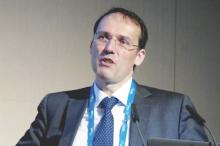BARCELONA – A modified form of ursodeoxycholic acid (UDCA) could offer patients with primary sclerosing cholangitis the first real pharmacologic treatment option, it was reported at the International Liver Congress.
Phase II study findings showed that a 1,500-mg daily dose of norursodeoxycholic acid (norUDCA) significantly (P less than .0001) reduced the primary endpoint of serum alkaline phosphatase (ALP) by 26% versus baseline levels within 12 weeks of treatment.
Other doses of norUDCA that were tested in the multicenter, randomized, double-blind, dose-finding study also produced significant reductions in serum ALP: –17.3% with a 1,000-mg dose (P = .0003), and –12.3% (P = .0029) with a 500-mg dose. The 1,500-mg dose has been selected for the follow-on phase III trial.
While this investigational drug is still only a symptomatic therapy and not a cure, it brings a viable option for managing the devastating but rare liver disease that currently lacks any effective therapy other than liver transplantation.
Primary sclerosing cholangitis (PSC) is an orphan disease that affects 1-16 in 100,000 people and typically strikes at a relatively young age, at around 30-40 years, with a male predominance. Often asymptomatic at first, the chronic disease can lead to liver transplant within 13-21 years of a diagnosis, with around half of all patients needing a transplant in 10-15 years.
This is the first trial of norUDCA in patients, lead study author Dr. Michael Trauner of the Medical University Vienna pointed out during the late-breaker session at the meeting sponsored by the European Association for the Study of the Liver (EASL).
“The role of UDCA in the treatment of PSC is still under debate and discussed controversially in the current guidelines,” Dr. Trauner noted. At a press briefing earlier in the day he had observed that there was not really any good evidence that it really worked in PSC, although it was approved as a treatment for primary biliary cholangitis.
norUDCA is a derivative of UDCA that has had a side-chain shortened by removing an ethylene group, he explained, and the resulting molecule is resistant to conjugation with taurine and glycine, which is part of process known as cholehepatic shunting. The resulting effect is protection of the bile ducts through the generation of bicarbonate-rich bile flow. Preclinical studies in mice have shown that norUDCA has potent antiproliferative, antifibrotic, and anti-inflammatory effects that, if translated into humans, could mean that norUDCA could have benefits beyond just addressing cholestasis.
“At the moment there is no medical treatment for PSC,” EASL spokesperson Dr. Frank Tacke of the University Hospital Aachen (Germany) commented at the press briefing. “We are very excited about these data because it is a new hope for this type of patient.” He added: “The fact that we have nothing to offer at the moment that works as a medical treatment makes this study so particular.”
Of 222 patients who were screened for inclusion into the study at 45 centers in 12 European countries, 161 met the criteria and were randomized, with 159 actually receiving their allocated treatment. There were 40 patients in the placebo arm, and 39, 41, and 39 patients, respectively, in the 500-, 1,000-, and 1,500-mg norUDCA arms. The two patients that did not receive allocated treatment had withdrawn their consent.
As expected, around 60%-70% of the patients in each group were male. The mean age was around 41-44 years, around one-fifth had a new diagnosis of PSC, and more than half (50%-77%) had inflammatory bowel disease (IBD) at screening, which was predominantly ulcerative colitis, Dr. Trauner observed. Patients also had pronounced cholestasis at the start of the study, signified by mean serum ALP of 400-500 IU/L. The normal range is between 44 and 147 IU/L.
“norUDCA reduced ALP in a dose-dependent fashion,” Dr. Trauner said. He noted that looking at changes in ALP over time, it was evident that there was a rebound effect after the treatment was stopped. The percentage of patients reaching an ALP equal to or below 1.5-fold the upper limit of normal, which has been shown to be prognostically meaningful in the disease, was 12.5% for placebo and 12.8%, 41.5%, and 30.8% for the three ascending doses of norUDCA.
Changes in serum levels of other important liver enzymes – gamma-glutamyl transferase, alanine aminotransferase, aspartate aminotransferase – showed a similar pattern in terms of absolute changes from baseline over time, with rebound effects once treatment stopped.
There were a comparable number of adverse drug reactions – 28%, 23%, 32%, and 28%, respectively, in the placebo, 500-, 1,000-, and 1,500-mg norUDCA groups. Treatment-emergent adverse events occurred in 80%, 59%, 73%, and 67%. The most common of these were gastrointestinal effects such as abdominal pain (12.5% for placebo vs. 2.6%-9.8% in the norUDCA groups) and diarrhea (10% vs. 0-7.7%), fatigue (10% vs. 4.9%-12.8%), arthralgia (10% vs. 0-2.4%), back pain (10% vs. 0-7.7%), headache (7.5% vs. 2.4%-17.9%), nasopharyngitis (17.5% vs. 15.4%-22%), and pruritus (10% vs. 7.7%-15.4%).


